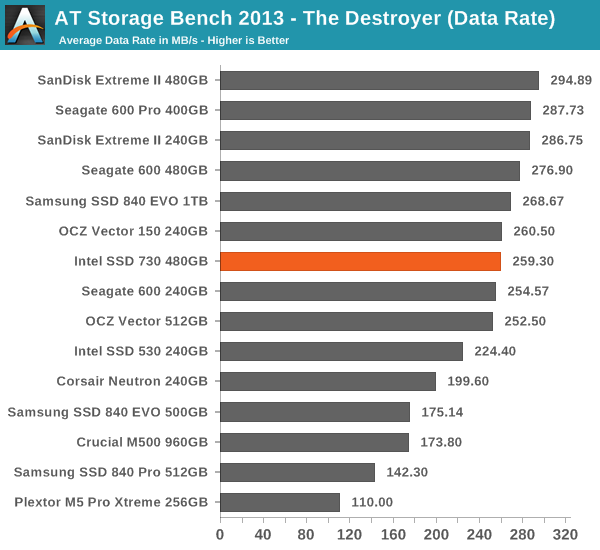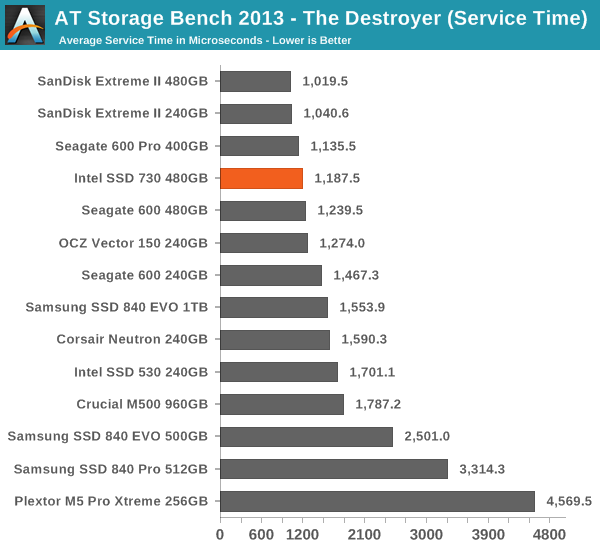Intel SSD 730 (480GB) Review: Bringing Enterprise to the Consumers
by Kristian Vättö on February 27, 2014 12:00 PM EST- Posted in
- Storage
- SSDs
- Intel
- Intel SSD 730
AnandTech Storage Bench 2013
Our Storage Bench 2013 focuses on worst-case multitasking and IO consistency. Similar to our earlier Storage Benches, the test is still application trace based—we record all IO requests made to a test system and play them back on the drive we're testing and run statistical analysis on the drive's responses. There are 49.8 million IO operations in total with 1583.0GB of reads and 875.6GB of writes. As some of you have asked, I'm not including the full description of the test for better readability, so make sure to read our Storage Bench 2013 introduction for the full details.
| AnandTech Storage Bench 2013 - The Destroyer | ||||||||||||
| Workload | Description | Applications Used | ||||||||||
| Photo Sync/Editing | Import images, edit, export | Adobe Photoshop CS6, Adobe Lightroom 4, Dropbox | ||||||||||
| Gaming | Download/install games, play games | Steam, Deus Ex, Skyrim, Starcraft 2, BioShock Infinite | ||||||||||
| Virtualization | Run/manage VM, use general apps inside VM | VirtualBox | ||||||||||
| General Productivity | Browse the web, manage local email, copy files, encrypt/decrypt files, backup system, download content, virus/malware scan | Chrome, IE10, Outlook, Windows 8, AxCrypt, uTorrent, AdAware | ||||||||||
| Video Playback | Copy and watch movies | Windows 8 | ||||||||||
| Application Development | Compile projects, check out code, download code samples | Visual Studio 2012 | ||||||||||
We are reporting two primary metrics with the Destroyer: average data rate in MB/s and average service time in microseconds. The former gives you an idea of the throughput of the drive during the time that it was running the test workload. This can be a very good indication of overall performance. What average data rate doesn't do a good job of is taking into account response time of very bursty (read: high queue depth) IO. By reporting average service time we heavily weigh latency for queued IOs. You'll note that this is a metric we've been reporting in our enterprise benchmarks for a while now. With the client tests maturing, the time was right for a little convergence.

Even though the performance consistency on the SSD 730 is great, it's only mediocre in our Storage Bench 2013. The write performance of SSD 730 is class-leading but as our Storage Bench has more read than write operations, the SSD 730 loses to drives with better read performance. Whether the drive should focus on read or write performance is a question with no single correct answer because it's workload dependent. The heavy enterprise workloads the SSD 730 platform was designed for tend to be more aggressive in writes, so giving up some read performance makes sense there and carries over into the consumer version.











96 Comments
View All Comments
Kristian Vättö - Saturday, March 1, 2014 - link
The endurance is based on a workload that consists mainly of 4KB random writes (I'm currently travelling and don't have the JDEC PDF at hand, but IIRC it was ~67% 4KB and then a variety of other IO sizes).The figures Intel provide are in-line with others. E.g. OCZ rates the Vector 150 at 50GB/day for 5 years. Consumer-grade drives are not validated as extensively as enterprise drives, hence the endurance ratings are lower. Furthermore, it's mainly a way to force enterprises to use enterprise drives because otherwise they could just throw in some consumer drives and then get them replaced under warranty when the drives wear out.
Gigaplex - Thursday, February 27, 2014 - link
"Even though the performance consistency on the SSD 730 is great, it's only mediocre in our Storage Bench 2013. The write performance of SSD 730 is class-leading but as our Storage Bench has more read than write operations, the SSD 730 loses to drives with better read performance."Uh... your graphs show it near the top of the charts for read, and in the bottom half for write. This comment makes no sense.
creed3020 - Friday, February 28, 2014 - link
Excellent point. This is review is filled with holes that tout this drive yet the numbers don't back it up.For it's price the drive is a non starter. I have a Seagate 600 240GB which I purchased for $139, that is a staggering $110 less than the 240GB equivalent here from Intel. The 5-10% performance improvement this drive has over my drive is not worth the price difference. Intel resting on it's laurels as usual.
CalaverasGrande - Thursday, February 27, 2014 - link
orientated?eanazag - Thursday, February 27, 2014 - link
What was left out of this review and it is understandable is how it handles various RAID configurations over time. More than RAID 0 or 1. I think that may be the more realistic usage model.I agree with most others. I am not seeing much traction for it because of pricing and lack of features. Maybe professionals. I'd need to look at this and the DC models to decide based on price.
bitcoder - Friday, February 28, 2014 - link
I agree on the RAID comments, since this is an "enterprise" ssd lets see how it works in tougher environment. Put some in a RAID configuration and then compare them against the other RAIDed drives in your bin. Consistent performance is a critical parameter when you put drives in parallel as the slowest one on any operation slows down the whole array.I disagree on the lack of features, I think a power loss (backup power caps) is much more likely than computer theft (encryption) of a desktop at my house. Maybe they had to turn off encryption because it was the slowest part of the silicon and prevented reaching these overclocking speeds.
chizow - Thursday, February 27, 2014 - link
Great synopsis and analysis of the evolution of SSDs since Intel's X-25M hey day, just as I recounted the events as well for the most part.I just don't see how Intel will sell many of these at the listed MSRPs, from what I saw it is still slower than the top 3 SSDs on the market (Samsung 840Pro, Sandisk Extreme II, Samsung 840Evo 250+GB) and it is much later and more expensive than the Extreme II and 840 Evo at least.
iwod - Thursday, February 27, 2014 - link
I am slightly disappointed.The Intel DC brings SSD Random IO consistency to the table. At the time where you can actually still feel pause on some pretty decent SSD. It was good because we reached the upper limit of Seq Performance with no replacement for SATA 6Gbps in sight, and Random Read Write has nearly level off between most SSDs.
Since then, most other top end SSD, from Latest Marvel Controller to Samsung has all provide very good consistency. As shown in the graph SANDISK Random IO variation are all well within 1x% range. And doesn't have Dot jumping everywhere on the graph. The same goes for Samsung as well. While Intel still brings the best consistancy performance, but it doesn't seems to me the tradeoff are worth it. From performance enthusiast perspective, Seq and Random IO still comes first. As shown in the Storage Bench the SSD 730 isn't the top performer, the highest power usage, and the most expensive as well.
What we need now is improvement on all front. Much faster Seq Performance, even PCI-E 3.0 x 2 will only brings us 2GB/s, which i guess will only take a year and half for SSD marker to saturate it. Faster Random IO, and finally much lower Power usage.
Samus - Thursday, February 27, 2014 - link
Considering you can buy two m500 drives for the price of one of the 730's, your better off raiding them together and getting superior performance, endurance, redundancy, and far less idle power consumption.Cost aside, this controller makes no sense for anything but a SQL, Exchange, web or heavy IO file server. The only desktop platform that'll take advantage of the performance consistency is video editing, but at 240 and 480 GB the capacities aren't high enough.
amddude10 - Friday, November 28, 2014 - link
The 730's power loss protection is supposedly much, much better than that of the m500